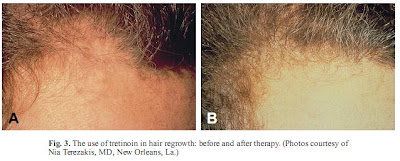Many of you have probably heard that soy isoflavones may be good for hair loss. How exactly dietary isoflavones work to promote hair growth is less clear, however.
As long-time readers may remember, I've written before about the effects of dietary isoflavones on humans and animals. For example, in male rats even a relatively low amount of soy isoflavones reduces DHT and increases testosterone. This alone would probably be enough to explain hair growth in rodents.
Of course, humans are a more difficult case. Most of the things that show promise in mice or rats don't work for humans with androgenic alopecia in the end. The good news is that soy isoflavones reduce DHT even in humans. The bad news is that the reduction may not be great enough. About 60 mg of isoflavones daily reduced serum DHT in healthy young men by only 15%.
Even this moderate drop would suggest a reduction in 5-alpha-reductase, which converts testosterone to DHT. However, the markers of 5-alpha-reductase looked at in the study did not show a difference between the treated and the control group.
And yet, a combination of capsaicin and soy isoflavones grows hair in both animals and humans. In this study, capsaicin injected into the skin was enough to grow hair in animals, although the combination was more effective. In humans, orally administered isoflavones and capsaicin resulted in hair growth in 88% of the participants with androgenic alopecia, which is a remarkable result for a supplement that reduces DHT by so little.
The authors speculated that capsaicin and soy isoflavones promote hair growth by increasing dermal levels of insulin-like growth factor (IGF-1). They suggested that a key factor was calcitonin gene-related peptide (CGRP), which acts as a vasodilator, among other things. It also increases IGF-1 in various tissues, including the skin.
This theory is supported by the fact that subcutaneous capsaicin increased CGRP release and IGF-1 expression in hair follicle cells in normal mice but not in CGRP-knockout mice. Soy isoflavones increased the production of CGRP, which explains why the combination was more effective than capsaicin alone.
Based on these studies, it was still unclear whether dietary isoflavones alone promote hair growth. Now, the same authors have investigated their idea further. In their new study, they fed isoflavones to mice whose backs were shaved and measured their hair growth (link). Again, both wild-type mice and CGRP-knockout were used.
The isoflavone supplement used was Fujiflavone P40, which contains 43.5% isoflavones. 5 g of the product was mixed per each kg of standard chow. On average, the mice ate 4.6 grams of food daily, which means that their daily intake of isoflavones was 0.0046 * 0.005 * 0.435 = ~10 mg (correct me if my calculation is wrong).
After three weeks of isoflavone administration, dermal CGRP and IGF-1 levels in wild-type mice increased significantly compared to the control group. In the knockout mice, no difference was seen between mice given isoflavones and the control group.
Hair follicle number also increased in wild-type mice given isoflavones. Compared to the control group, they had about 40% more hair follicles. The knockout mice had less hair follicles to begin with, and when they were given isoflavones, no improvement was seen. Thus, it seems that isoflavones grow new hairs through increasing dermal levels of CGRP and IGF-1.
Compared to the mice given isoflavones, the control mice seemed to take a longer time growing their existing hair back. Even the knockout mice that saw no increase in IGF-1 grew their hair back quicker when they were given isoflavones. This might be due to other effects of isoflavones, such as reducing DHT levels. Based on the pictures in the full paper, the wild-type mice grew their hair back even quicker, however. Wild-type mice given isoflavones also had a more pronounced darkening of hair than their control group.
So what is the take home message? Based on all these studies, it looks like soy isoflavones show very good potential for promoting hair growth. A part of their effectiveness may come from the fact that they reduce serum DHT and increase testosterone, but based on the rodent data, the real kick is from the increase in skin levels of IGF-1.
At the moment, there is no data comparing the effectiveness of soy isoflavones vs. capsaicin in humans. However, we do know that the combination is superior in increasing dermal IGF-1 in animals, and that the combination of both taken orally grows hair in humans with androgenic alopecia.
For more information on hair growth, see these posts:
Topical Retinoids Increase Hair Growth in Most People
BioSil, JarroSil & Beer – Silicon Experiment Conclusion
Zinc Pyrithione Reduces Shedding and Moderately Promotes Hair Growth
Hair Growth with Ayurveda – The Nutrich Oil Experiment






